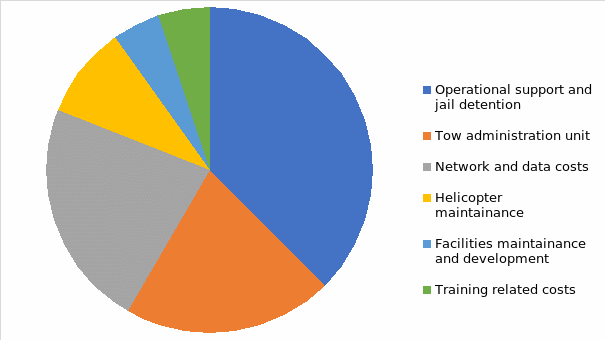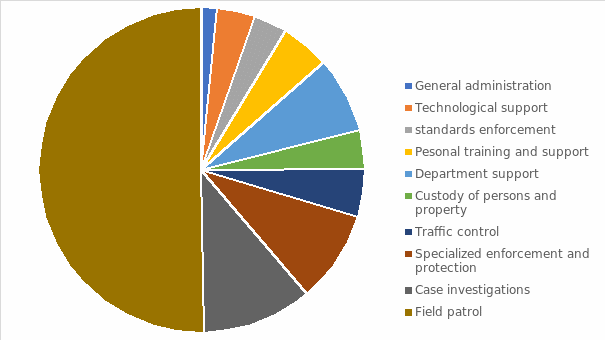Abstract
The compilation of LAPD’s annual budget involves the administration of all fiscal resources, including the acquisition of all equipment and supplies, management of contracted services, and the processing of travel and training expenses. The Administrative Services Division (ASD) is responsible for the centralization of fiscal wage bills and synchronization of facility services for the Department. In addition, ASD develops and administers grants and other special funding, as well as provides department-wide payroll services and prepares special reports, research, and internal audits. It is solely in charge of organizing the upkeep of all current police facilities, supervising the construction of new ones and requesting space for departmental contracted needs. The foundation of this paper is a breakdown of the LAPD budget, its components, revenue sources, and funding streams, as well as a proposal to reduce the budget and its effects.
Historical Background
The general expenditure for the Los Angeles Police Department (LAPD) has been steadily increasing over the past 11 years. During the 2011-2012 financial year (FY), the budget was $384.9 million. The current budget of $1.7 billion million in 2022 represents a 22.6 percent increase over a ten-year period (Libby, 2020). However, the Great Recession of 2008 forced the Department to adopt significant cutbacks in budgeted staff beginning in financial year 2010 in order to address persistent general fund budget deficits, making FY 2011 the lowest budgeted year since the recession. The section that follows highlights the major components of the LAPD’s annual budget.
Components of the Budget
According to the comptroller of public budgets, LAPD’s 2021–2022 budget stands at US $1,733,838,124, which represents a total of 15.1% of the state allocation. The budget, which was signed and approved by Los Angeles mayor Eric Garcetti, is diversified to meet operational costs in ten dockets within the department. The US $1.7 billion is split as follows: 50% goes to patrol division overheads, 11% goes to case investigations, 9% goes to specialized enforcement and protection units, 8% goes to departmental support costs, 5% goes to personnel training and recruitment, and 4% goes to technological upgrades within the department. An additional 3% is allocated to standard enforcement and quality control, with the remaining 1% going to general administration. Furthermore, the traffic control division receives a 5% cut, with the remaining 4% going to financing processes involved in the custody of persons and property. The department also incurs other miscellaneous expenses which are covered under department support and general administration as highlighted in the section below. The section that follows blends a detailed analysis of individual entities contained in various budget entries.
Overview of Specific Operations
Expenses covered under general administration include but are not limited to the costs of developing tools of analysis to reduce crime and the movement of inmates between correctional facilities. In addition, the improvement of public safety through the provision of street-level support to patrol officers to address crime incidents falls under this tenet. Other costs associated with the enhancement of analytical support to forensic experts to aid in suspect profiling and apprehension; and conducting research on emerging trends and technological advancements to further intelligence-led crime control can also be considered here. The cost of computer upkeep, updating cyber security tools, criminal data management systems, and hiring professional IT services relating to technological support Hardware and software acquisition charges such as leasing durable tablets and computer backup systems are included in this docket during budgeting. The field patrol caters to salary expenses such as flexible benefits, holiday premium pay, recruitment allowances, pensions for retired officers, and tuition reimbursement. In addition, uniform charges, the cost of repair and maintenance of equipment such as patrol cars and communication and tracking devices, fall under this sub-category. On the other hand, US $158,987,488 allotted to specialized enforcement and protection covers a proportion of overtime costs as well as contractual agreements discussed below.
Contracts
LAPD ranks these costs as either non-discretionary or reimbursable, and they are only incurred if the specified purpose is accomplished. There are two key overtime components, namely, community policing and special events, both of which are linked to service programs that are allocated specifically in a specific fiscal. The subcategories that make up these tenets total $34.1 million, which accounts for about 44% of the department’s entire overtime spending. The remaining $23.2 million, or 41% of the department’s overtime budget, is used in areas where the department has more discretion. Special events range from presidential visits, waste and debris management initiatives, and state diplomatic tours, to business fairs held by commercial banks, to sporting activities in parks, games, and stadiums. In addition, the department incurs standard enforcement costs to ensure smooth running of data servers, functionality of water and sewerage facilities in inmates’ facilities, and maintenance of air vessels, among other emoluments as shown in the chart below.

Budget Chart Representation
An analysis of the information on the chart indicates that indirect costs increased by $6.0 million, or 9.5 percent, owing primarily to an $8.8 million increase in non-discretionary expenses offset by a $2.3 million decrease in departmental support costs. The funding level of non-discretionary costs is determined by the department itself and not the comptroller and includes IT-related costs ($16.8 million), fleet vehicle and freight costs ($15 million), and utilities ($4.7 million) for the department’s financial year 2022 budget.

New Budget Proposals
Since the recession that started in 2007, almost every public safety agency has had to implement significant budget cuts. The global economic drawdown as a result of the 2020 COVID-19 pandemic necessitates the need to reduce LAPD’s share of the state budget. The economy is recovering gradually from a recession phase, and reducing expenditure on public goods and services will effectively catalyze this process. Large appropriations should be directed to capital-intensive projects in order for the economy to restore its pre-pandemic projections.
Further Reading
In this regard, the Los Angeles City Council should enact a 10% budget cut followed by a 15% budget cut. During this initiative, 220 LAPD security personnel will be reassigned from their specialized units, with the aim of dissolving and downsizing a variety of programs in order to resolve the city’s fiscal crisis. The Homeless Outreach and Proactive Engagement (HOPE) unit, which was being run by 45 officers and four sergeants, will be the largest of the disbanded cohorts. The 10% cut means that $173 million in police services will be diverted to anti-gang campaigns, universal income schemes, homeless services for the disenfranchised, education and career development, and other causes. An additional 15% cut (US $260 million) will be directed to financing community-based projects such as youth health sensitization programs and funding for non-governmental organizations that deal with emergency responses and environmental conservation. In addition, the department will eliminate or dismiss applications to fill any existing or pre-existing vacancies as well as those that might accrue during this period. The section below contains more information concerning other relevant budget restructuring strategies.
Recommendations
The suggested cutbacks will not necessarily involve layoffs and retrenchments. Instead, officers from defunct special teams will be transferred to vacant slots in patrol and investigation operations at different stations. The Safer Cities Programme in the Mission Area, which includes units specializing in sexual violence, homeless advocacy, larceny, and animal cruelty, will all be fully abolished. Those six divisions include a total of around 95 police officers who will be relocated. Officers who are likely to retire within the next four months are included in some of the numbers. In this proposal, the Hollywood Entertainment and Pacific Area Beach Units, University Park Task Force, Homicide, Commercial Crimes, Metropolitan, Traffic, and Labor Relations Departments are all scheduled for downsizing. A total of 127 officers will be transferred as a result of these changes, with the most significant drop occurring in the Traffic Group, which will lose 40 officers. Additionally, the use of police vehicles during patrols will be limited to night hours in order to cut down the cost of motor vehicle fueling, repair, and maintenance. Some of the contingencies that satisfy the need for the recommended budgetary amendments are highlighted below.
Justification
The increase in cases of police brutality portrayed in cases such as the killings of George Floyd and Breonna Taylor calls for the defunding of the police force. Activists claim that, by implication, the police and other law enforcers have been given excessive funding and duties for dealing with societal issues. Furthermore, petitions from lawyer Angela Davis and agencies like the People’s Budget L.A. have magnified the need to solve crimes through care, assistance, and corporate philanthropy instead of involving the police. Advocates have been lobbying for these reforms for a long time, and data analysis backs them up. According to a recent study by Solace Research, a US-based not-for-profit organization, more than half of the mentally ill inmates in the Los Angeles County Jail were eligible for diversion to community-based therapy programs rather than imprisonment (Libby, 2020). This reveals how, in the United States, police jails and prisons have become an unofficial mental health care system. The suggested proposal will definitely introduce the entire Los Angeles fraternity to a new coexistence era with few policing and other security-related interventions that will result in some of the outcomes discussed below.
Outcomes from the Budget Cut
This budget revision is a chance to move past LA’s lengthy history of police violence and marginalization to promote equal outcomes for African American citizens. There are numerous worthwhile departments, institutions, and projects in which the finances from LAPD’s budget cut can be re-invested, resulting in a healthier, more productive population while reducing crime. Redirecting resources and responsibility away from the police and into community-based safety, support, and preventive strategies is more likely to facilitate the state’s effort of equal representation while reducing social unrest caused by the police. However, it is not guaranteed that a police-free society will experience few or no cases of violence. Criminals may take advantage of the situation to perpetrate their ill-intended motives, leading to a more chaotic and insecure state. It calls for personal responsibility among citizens to ensure that Los Angeles remains peaceful, drug-free, and serene even with a few officers conducting patrols in the streets.
Reference
Libby, D. (2020). City Council Votes to Slash LAPD Budget.